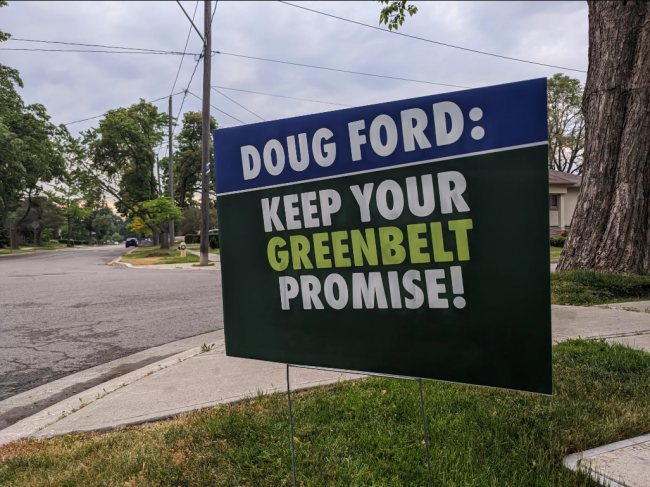Articles Menu

Sept. 25, 2023
Thanks to the work of the auditor general and the integrity commissioner, people in Ontario are now very awake to the deceit and corrupt practices involved in the attack on the Greenbelt, city planning and the ability to build homes where we need them.
But less clear is what drove the government to become so captured by the power and influence of the development industry.
I think we can get a lot of insight into how this started by looking at a key aspect of the 2018 election that brought the current government to power.
Premier Doug Ford was elected with the aggressive and pervasive support of Ontario Proud’s online attack machine on Facebook. Elections Ontario reporting after the vote revealed Ontario Proud was not funded by grassroots supporters, as was claimed during the election, but rather by a consortium of suburban sprawl developers, with the biggest donor being Mattamy Homes. In total, developers contributed $500,000 for online attack ads against the incumbent Liberal government and its premier, Kathleen Wynne, many of them viciously misogynist and homophobic.
As a result, these developers grabbed the ear, and the thanks, of the newly elected premier and his government. As the premier himself has said, these people are his friends.
This is because they make vast sums of money buying farmland cheap, getting it rezoned for development and then eventually building expensive low-density sprawl on it.
They also were clear that they do not want to pay for the costs of sewers, roads, water supplies, schools and parks that these developments make necessary.
So for their election work, these developers now had a good friend in the premier's office. A friend who wanted to help them.
What drove Doug Ford's Ontario government to become so captured by the power and influence of the development industry? asks @CanadaGray @envirodefence #HandsOffTheGreenbelt #Onpoli #ClimateCrisis - Twitter
They also were presented with another opportunity: Housing prices.
Rising housing prices in Ontario had been driven by years of historically low interest rates, foreign and domestic buyers who saw houses as a lucrative and “no lose” investment opportunities, changes to tax laws that killed rental housing construction and governments halting the funding and building of affordable homes, like co-ops. These factors all combined to cause a decade-and-a-half escalation in housing prices to increasingly unaffordable levels.
Then enter the COVID-19 pandemic, inflation and rapidly rising interest rates, and we had a situation where homes that were previously expensive suddenly leap out of reach for all except those with very high incomes, an existing high-value property or very wealthy parents.
A long-simmering problem became a crisis and the classic tactic of turning a crisis into an opportunity was not unknown to the billionaire-sprawl developers and their friends in the Ford government.
And so began the loud and repeated proclamations by the premier, his ministers and developers: “Environmental protection, planning rules and the Greenbelt are creating a scarcity of land available to build homes and that is why house prices and rents are so high.”
For the average person who does know the details of how housing supply and prices work, this logic sounds reasonable: if you increase the supply of something, then it should become cheaper. Unfortunately, this is a situation where the simple conclusion is also the wrong one.
First, there was — and is — no shortage of land designated for housing construction.
This is because cities and regions in Ontario are required by law to identify and zone lands sufficient to meet their projected housing needs for decades to come. They are also required to update these plans frequently and to account for any new people who are projected to arrive. Most regions have consistently overestimated these new arrivals and, therefore, also overestimated the amount of land that would be used to build homes, so there were huge land surpluses when the current government was elected.
The other aspect of the misunderstanding is that making more land available won’t mean more homes will be built.
This is because almost nobody seeking a newly built house in the Greater Toronto and Hamilton Area buys a plot of land, hires an architect and builds their own home. Instead, we all buy a new home or a condo from a large development corporation.
It makes no business sense for these developers to sell any home they build for less than they can extract from the marketplace. Therefore, they put newly constructed homes into the market at a rate that ensures consistent— and they hope — high and escalating prices.
Scarcity fits their business model.
So developers have no interest in making homes more cheaply and anyone looking for a newly built home has to buy from developers, who control the supply.
As our auditor general, integrity commissioner and Housing Affordability Task Force have all shown, none of these facts mattered to the Ford government and their developer friends. And so the attacks on decades of planning progress and the Greenbelt began, and we all got to suffer the results of a government paying back the friends who helped bring it to power.
Massive public backlash, cabinet minister resignations and steaming evidence of the scale of the insider dealing and developer favouritism have now forced the premier to backtrack on the Greenbelt land removals.
This is an incredibly well-earned victory for the people of Ontario, but only the results of deeper probe will help us chart a path back towards an approach to urban planning and environmental protection that focuses on the public interest rather than that of those tied at the hip to the current government.
Tim Gray is the executive director of Environmental Defence. Tim grew up on the shores of Lake Huron and acquired his love of nature there. He has over 25 years of experience developing and implementing environmental policy change efforts.
[Top photo: Ontarians are awake to the deceit and corrupt practices involved in the attack on the Greenbelt. Photo by Shutterstock]